Caribou Captive Breeding Program May Come Too Late To Prevent Extinction In National Parks
 The Tonquin and Brazeau caribou herds in Jasper National Park are now so small that they cannot recover on their own. (Parks Canada) Edward Struzik, Queen's University, Ontario
The Tonquin and Brazeau caribou herds in Jasper National Park are now so small that they cannot recover on their own. (Parks Canada) Edward Struzik, Queen's University, Ontario
In October, more than two years after the last caribou in the Maligne Valley of Jasper National Park died or disappeared, Parks Canada announced a tentative plan for a caribou captive breeding program. Subject to an expert review that will likely take place in January, females from other herds will be rounded up and penned in a facility near the town of Jasper.
Stan Boutin, a biologist from the University of Alberta, sees these desperate measures as necessary — and these are desperate times for caribou herds.
There are now only three herds in Jasper National Park. None of them are faring well. The 45 animals in the Tonquin herd are down by a third since 2010, the Brazeau herd is left with just 15 animals, and neither has enough females to grow the population. The last stronghold is the À la Pêche herd, with 150 caribou that move precariously in and out of the north end of the park.
Decades of planning
Parks Canada has been looking for ways to save the caribou in its mountain parks for decades. In 2002, it floated a plan to close the Maligne Road that takes vehicles up to the base of the caribou’s alpine winter range, so that it would be harder for wolves to access the dwindling herd.
But officials dropped the idea four days after the plan was made public and the business community complained. The caribou recovery plan never made it to the public consultation phase. The business community high-fived. Park biologists licked their wounds.
 Caribou ranges for Jasper National Park. (Parks Canada)
Caribou ranges for Jasper National Park. (Parks Canada)
Scientists were hugely concerned that a large animal like caribou could disappear from a national park in Canada as the herd in Banff did in 2009. Writing in Conservation Biology, several noted that Banff National Park’s last southern mountain woodland caribou died the same day a coalition of conservation groups announced the Banff Spring’s snail was the “only species out of 449 listed under the Canadian Species at Risk Acts to benefit form the fully legally mandated conservation process.”
Federal legislation compels the government to protect species at risk, and in 2011, it launched a captive breeding program for southern mountain caribou with Parks Canada, the B.C. government and the Calgary Zoo. It was supposed to be a new beginning and the cornerstone of the caribou conservation strategy, but the agreement fell apart in 2015.
Science-based conservation programs in the mountain parks have long been pitted against tourism. Jasper’s resource conservation manager was fired in 2015 without cause, though many suspect that it was because he had pushed for the release of an overdue report on how a Jasper ski hill expansion would affect the threatened Tonquin caribou herd. His departure coincided with a plan to build overnight tourist accommodations in the Maligne Valley.
Decades of decline
It’s not just caribou in Jasper, Banff and other mountain national parks that have suffered. In the 1970s, Parks Canada dithered on stopping the serious decline of the woodland caribou in Pukaskwa National Park on the shores of Lake Superior.
There were only about 24 caribou then, and the population collapsed to just five individuals in 2009 and then disappeared entirely. Caribou might never have had a strong foothold in Pukaskwa, but the approach of doing nothing while watching the population’s extirpation wasn’t a plan either.
 A Parks Canada biologist holds an antenna aloft to track caribou in the Tonquin Valley of Jasper National Park. (Ed Struzik), Author provided
A Parks Canada biologist holds an antenna aloft to track caribou in the Tonquin Valley of Jasper National Park. (Ed Struzik), Author provided
It’s not that Parks Canada is doing nothing about endangered species and wildlife recovery. Bison were reintroduced successfully into Banff recently, but bison can adapt to almost any ecosystem. To its credit, Parks Canada also proceeded with the difficult challenge of removing exotic trout from many of the mountain park lakes by poisoning them, which could have been a public relations nightmare.
Read more: Historical photo of mountain of bison skulls documents animals on the brink of extinction
Caribou are different. Like polar bears, they are climate-challenged animals. They need alpine space, buggy bogs and forested fens in order to escape predators, flee from wildfire and find the food they need to survive.
They’re having hard time doing that outside of national parks, where the peatlands in oil and gas developments, logging and coal mining sites are being carved up and eaten by roads, seismic lines and oilsands operations.
In 1992, naturalist Ben Gadd predicted caribou would disappear from Jasper if Parks Canada didn’t set aside two large exclusion zones to protect them. He and other members of the Jasper Environmental Association had the ear of park biologists back then, but not the support of Ottawa.
Senior officials have consistently bent to the will of those in the business community to expand ski hills and build roads and monuments, including the monstrous Mother Canada Monument in Cape Breton National Park, even when it violated the spirit of the National Parks Act.
Ministers rarely come to the rescue because few stay in the job for long. Since 1971, there have been 30 ministers in charge of Parks Canada. Just two lasted more than three years, and 16 held the job for less than or little more than a year.
Not enough caribou
In 2018, Catherine McKenna, the longest serving environment minister, realized Parks Canada had lost its way when she said it was time to send the agency back on a conservation course. With McKenna now serving as infrastructure minister, judges and environmental groups are trying to hold Parks Canada and the federal government accountable.
Read more: It's time to press the reset button on Canada's national parks
The caribou recovery program in Jasper is sorely needed, but it is likely too little, too late. There are just not enough caribou around to grow the herds.
It also suggests that it’s easier for the Canadian government to pen and rear caribou in captivity than it is to deal with the issues threatening them in the wild. And that’s a sad commentary on an agency whose “first priority” is to protect the “natural and cultural heritage of our special places and ensure that they remain healthy and whole.”
Prime Minister Justin Trudeau had nothing to say about ecological integrity in national parks when he handed Jonathan Wilkinson his mandate in overseeing Environment Canada and the Parks Canada agency. What’s needed is a national board of advisers with a compelling legal mandate that can hold Parks Canada’s feet to the fire and shield it from political interference. Business as usual will not be successful in this era of climate change.
![]()
This article was written by Edward Struzik, Fellow, Queen's Institute for Energy and Environmental Policy, School of Policy Studies, Queen's University, Ontario
This article is republished from The Conversation under a Creative Commons license. Read the original article.






Comments
It's hard for me to even look at this article. Just look at what's being said. Jasper's "last stronghold is the A la Peche herd, with 150 caribou" and only this past October, "more than two years after the last caribou in the Maligne Valley of Jasper National Park died or disappeared, Parks Canada announced a tentative plan" for dealing with the situation. "Parks Canada has been looking for ways to save the caribou in its mountain parks for decades" and "floated a plan" in 2002, but "dropped the idea" because "the business community complained" and they're just now concluding that "the approach of doing nothing while watching the population's extirpation wasn't a plan..."
According to the article, they now suspect that caribou might be negatively impacted in areas "where the peatlands in oil and gas developments, logging and coal mining sites are being carved up and eaten by roads, seismic lines and oilsands operations." Really? Do you think so? When do we think Canada might wake up and realize that the bulk of those oil and gas developments, roads, seismic lines, and oilsands operations are being backed by predatory republican corporate interests from Texas, at least when those Texans can spare time from their relentless efforts to overturn democracy down here in America?
The article goes on to tell us that, in Canada, "officials have consistently bent to the will of those in the business community to expand ski hills and build roads and monuments ...even when it violated the spirit of the National Parks Act" and that ministers in charge of Parks Canada "rarely come to the rescue because few stay in the job for long." According to the article, out of thirty ministers in charge of Parks Canada since 1971, only two lasted more than three years, and sixteen served "for less than or little more than a year." Yet, the author still clings to the fantasy that it's "not that Parks Canada is doing nothing about endangered species and wildlife recovery." Really? Based on the evidence, they were well on their way to having me fooled!
The sad truth is that, when breeding populations of any species are allowed to drop this low, there is already too much gene pool loss to offer much hope of pulling them back from the brink of inbreeding. Yes, you can and, at this point, must mix specimens from other populations into their captive breeding pool; but, the result of that kind of strategy will be hybridized animals, further downselected through the very process of captivity. In all probability, such specimens will retain a mere echo of the natural genetic adaptations that originally enabled these specific caribou to thrive in their particular mountain environments. These hybridized specimens may or may not still be able to adapt; but, you're rolling the evolutionary dice and having to do so because you failed to do your job in the first place. O Canada, O Canada, can no one bother to stand on guard for thee? And against a bunch of greasy corporate parasites no less?
But, at the same time, it's too easy for me to be outraged about what is happening in Canada when the Trump Administration and corrupt filth like Texans Ken Paxton and Greg Abbott and Greg Gianforte, Steve Daines, Ryan Zinke, David Bernhardt, and all the rest of the republican garbage have been doing exactly the same thing, if not worse, down here. How can I complain about Canada's disgrace in having sixteen ministers in charge of Parks Canada since 1971 who have served "for less than or little more than a year" when our own NPS hasn't had a real director since Trump took office? No, there's more than enough shame to go around, which is why America has to set a better example by prosecuting the Trump family and, wherever possible, their enablers this coming spring and jailing them as they deserve. After all, aren't they the ones who originally wanted somebody locked up? The least we can do is give them what they wanted.
Extinction is a common and normal part of Nature. Consider the many species that have failed to adapt and have gone extinct. Let the Caribou adapt or go extinct.
Yes, Bill Baehr, to some people, extinction is common and normal. But, of all the sad examples of the pot calling the kettle black, are you, of all the most oblivious people in the world, really sure you're the one to champion the "look to the future" and "adapt or go extinct" banners?
I can't be sure where you've wandered or what you're doing now; but, the conservation of native wildlife species is an important part of the national park mission and, the last time I ran into you, you were associated with a snarky dude ranch operation using its entrenched location at a high-buck national park to draw well-heeled tourists for an expensive and much balleyhooed old-timey, cowboy-themed, outdoor entertainment business. I recall you doing horse rides.
If that's still the case, have you looked in the mirror or around you lately? If that's still the case, have you noticed that you're making a good share of your pocket money off a national park and your opportunity to do that would diminish, if not disappear, without that national park? If that's still the case, have you noticed that you're in the business of celebrating a "custom and culture" that didn't adapt and is now pretty much obsolete, if not extinct? Ranches are now mostly corporate operations. Real cowboys are now mostly underpaid immigrant hired help wearing discount store sweat pants and running shoes and riding company ATVs. The "custom and culture" that you celebrate is now more of a playtime lifestyle for wealthy trust funders. But, if you're still in that line of work, have you noticed that a good share of your pocket money comes from rich tourists, including rich foreign tourists, who, by and large, fly in and arrive in modern catered vans or luxury rentals? Do you lecture those foreign tourists about your xenophobic resentments or keep that part to yourself and, if you do lecture them, do you do it before they pay for your song and dance on the trail or wait until afterwards? The NPS center at Colter used to host craft demonstrations of by notable Crow, Blackfeet, and Shoshone tribal artisans. Did you ever march your European-descended self in and proclaim to them that you are a "native" or have you just kept that to yourself in those situations?
Look, Bill, the point is that your "thinking" is so full of what we might euphemistically call "inconsistencies" that it's hard to even try to start seriously communicating. You rely on and profit from a national park or at least used to, yet don't comprehend or actually even respect the very fundamentals of the national park mission. You champion the "adapt or go extinct" banner, yet remain oblivious to the fact that you cherrypick, celebrate, defend, and make money off a "custom and culture" that refused and continues to refuse to adapt and is now pretty much extinct. You showcase your xenophobia, disrespect your own foreign customers, and proclaim yourself to be a "native" while genuine Native Americans stand by shaking their heads in wonder and amazement. You're just so "inconsistent" that I have to wonder at your lack of "self-awareness" I guess?